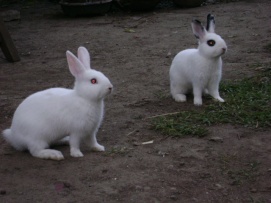
Rabbits vary in coat color. It is impossible to confine rabbits' coat color to one particular combination. They may be gray, white, brown or spotty. Generally rabbits are referred to as domestic animals. There are, however, species that are considered to be a part of wildlife, such as Cottontail Rabbits, which are found in Maryland and which are sometimes sheer trouble for local farmers. But even wild species of rabbits can be domesticated easily.
Rabbits are naturally gregarious. Wild rabbits live in communities while domestic rabbits are generally kept in cages containing several animals. All rabbits are herbivorous. They take lettuce, alfalfa, clover, grass and other herbs, containing large amounts of vitamins. They also feed on rabbit droppings that are rich in proteins. Feeding usually occurs in the morning. There are various pellet foods produced for domestic rabbits.
What makes rabbits attractive for pet lovers is their relative ease in care and funny behavior. They are highly tamable and, like cats, can promptly learn go in a litter box. They are less picky than many other domestic animals. Rabbit keeping is well studied and feeding instructions, as well as guideline materials on rabbit keeping, are widely spread and available. Another attractive feature is lack of aggression. Rabbits are commonly kind-hearted and amiable, but they have sharp teeth and claws, so, if scared or hurt, they may show an outbreak of violence.
Rabbits live 5-10 years. By age of 6-10 months, bucks (males) reach sexual maturity. Does (females) become mature after 5-9 months from birth. Gestation period is approximately 30-32 days, litters average 10 bunnies. Cottontail rabbits are high reproducers. A female can reproduce right after giving birth and can bring up to 5 litters per season. This fact is attributable to high populations of Cottontails.
If you are determined to keep rabbits, it is absolutely necessary that you get yourself a thorough instruction on rabbits' nutrition and anatomy. Rabbits are extremely delicate and the slightest negligence or mistreatment can be harmful or fatal for your future pets. You should also carefully study all diseases, typical of rabbits, and types of medicine for them.
Rabbits - Health Care
If you are going to devote your life to the breeding of rabbits, you should carefully study what you are likely to face regarding the matter of diseases and treatment. Rabbits, being very delicate by nature, are extremely susceptible to numerous infections and parasites. If you happen to discover an infection in your rabbit, do not try treatment on your own, but rather turn to a veterinarian.Infectious diseases demand specific and highly qualified treatment, and, considering the precarious intestinal bacteria balance, there should be no attempts by non-specialists to handle the problem. Improper antibiotic therapy may lead to the killing of many beneficial bacteria and trigger a serious disturbance in intestinal bacterial balance. Infections impacts vitally important organs (lungs, kidneys, liver) resulting in abscess (accumulation of pus), and thus preventing those organs from proper functioning.
Rabbits are also prone to parasitic diseases, such as 'Walking Dandruff'', caused by Cheiletiella mange mite, flea infestations and which, in hard cases, may end in considerable blood loss. Ear Mite infestation causes severe inflammatory reactions in external ear areas. Coccidiosis is caused by one-cell organisms. The disease affects liver and intestinal tract. The disease can be difficult to eradicate, therefore prevention measures are much more efficient.
Some illnesses are related to care and living conditions. Rabbits, like cats, use their tongues when caring for their hair. Many fall-out hairs are swallowed and form pellets inside the stomach. Rabbits cannot regurgitate, thus, the pellets grow bigger leaving little space in the stomach for food and makes it impossible for the animals to feed properly. There are some conservative treatment methods, like using intestinal lubricants; however, all too frequently a surgical operation becomes necessary.
Because rabbits are very active and curious, their movement around the apartment must be strictly controlled. Rabbits are fond of chewing, and they are no less crazy about chewing on electric cords, which may often end up in electrocution. Poisonous plants can also be dangerous because rabbits are not visually capable of distinguishing between poisonous and nonpoisonous plants.











